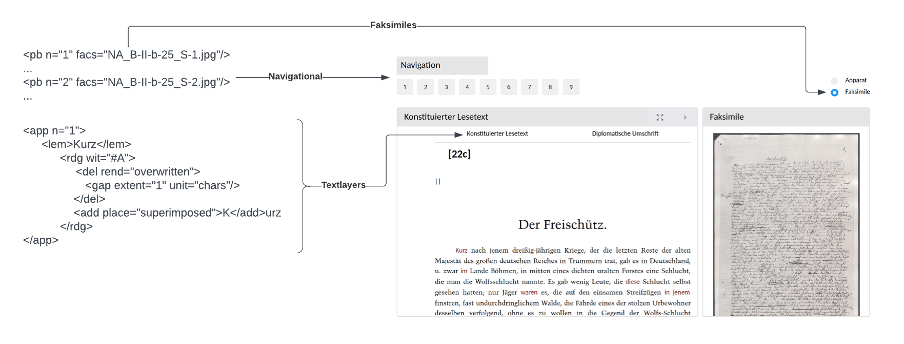On the Relationship Between Interfaces and TEI in Digital Scholarly Editions
Authors: Herbst, Yannik Werner / Roeder, Torsten / Saderi, Seyed Mohammad Sajad
Date: Thursday, 7 September 2023, 11:15am to 12:45pm
Location: Main Campus, L 1.202 <campus:note>
Abstract
Graphical user interfaces, as communication channels between man and machine, represent a crucial ingress route for the use of digital editions. They are an expression of culture-specific forms of access to digital resources, they can be seen as an intentionally designed usage guideline (cf. Dillen 2018), and further as »arguments« of editions themselves (cf. Andrews/van Zundert 2018). Under the paradigm of separating the representational (data) layer from the presentational (output) layer, they serve as a bridge by mediating one into the other, appearing as integral parts of the presentation determined by the underlying data.
The steep increase in the number of digital edition projects has led to repeated ventures to generalize this mediating function and integrate it into frameworks for digital editions. Multiple-use interfaces seem attractive, however their development is costly, and so far they could only be realized convincingly on a relatively basal level or under the condition of sufficiently large similarities of the underlying data (cf. Galka/Klug 2023). An outstanding approach is, for example, the TAPAS project (2016), where the used XSLT script can be selected during use. Fechner (2020) proposed to use a manifest to fill the gap between edition data and their interfaces, based on the example of IIIF. Relevant parts of this approach have already been implemented in the ediarum.WEB (2020) software library, and allow digital edition projects to focus development work on data modes and interfaces.
Even though interfaces of digital editions come in a variety of forms, the object description already captured in ediarum.WEB can be translated into reusable components. We will demonstrate how the framework »Synopticon« (cf. Herbst et al. 2023), developed at the Center for Philology and Digitality (ZPD) of the University of Würzburg, takes up this idea and tries to achieve a generic, modular, and adaptable solution for recurring structures in synoptic interfaces of digital editions. For this purpose, the single TEI-encoded text is modeled as a triad of navigation, text layers, and meta-information in order to juxtapose several such units. The fact that these components are already implicitly contained in TEI documents, queries or document transformations (cf. figure 1), shows how strongly intertwined the interface and the TEI document are, despite the paradigmatic separation of data and presentation layers. From this perspective, the interface appears as a purpose-built derivative of the data layer.

Additionally, to these tasks, the long-term implications of an interface description model need to be discussed. Due to the increasing relevance of digital heritage, the requirement to describe digital interface components in TEI will emerge in the foreseeable future. Digital interfaces constitute para texts (cf. Dillen 2018) which are comparable in their purposes to material text. For these, the TEI provides sufficient elements and attributes. Can an interface description model also provide a means of describing older digital interfaces and, at the same time, support the generic generation of new interfaces? Or are these two different sides of the same coin?
Bibliography
Andrews, Tara L. and van Zundert, Joris J. (2018): »What Are You Trying to Say? The Interface as an Integral Part of Argument«, in: Digital Scholarly Editions as Interfaces, Schriften des Instituts für Dokumentologie und Editorik, Band 12, hrsg. von Roman Bleier, Martina Bürgermeister, Helmut W. Klug, Frederike Neuber und Gerlinde Schneider, Norderstedt: BoD, S. 3–33, http://nbn-resolving.de/urn:nbn:de:hbz:38-91064.
Dillen, Wout (2018): »The Editor in the Interface: Guiding the User through Texts and Images«, in: Digital Scholarly Editions as Interfaces, Schriften des Instituts für Dokumentologie und Editorik, Band 12, hrsg. von Roman Bleier, Martina Bürgermeister, Helmut W. Klug, Frederike Neuber und Gerlinde Schneider, Norderstedt: BoD, S. 35–59, http://nbn-resolving.de/urn:nbn:de:hbz:38-91116.
ediarum.WEB (2020): Berlin-Brandenburg Academey of Sciences and Humanities, https://github.com/ediarum/ediarum.WEB.
Fechner, Martin (2020): A Standardized Interface for Digital Scholarly Editions, Berlin-Brandenburg Academey of Sciences and Humanities, https://nbn-resolving.org/urn:nbn:de:kobv:b4-opus4-33277.
Galka, Selina, & Klug, Helmut W. (2023): »Minimal Editing: Die Hyperdiplomatische Transkriptionsplattform«, 9th DHd conference, https://doi.org/10.5281/zenodo.7715321.
Herbst, Yannik; Roeder, Torsten & Reul, Christian (2023): »Synoptische Interfaces Digitaler Editionen«, 9th DHd conference, https://doi.org/10.5281/zenodo.7715462.
TAPAS (2016): Northeastern University Library’s Digital Scholarship Group, https://www.tapasproject.org/.
Contribution Type
Keywords